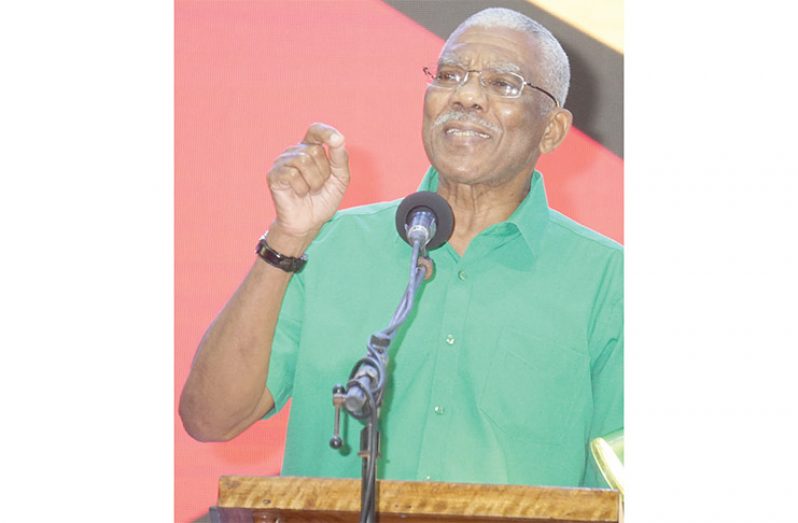…President unveils four-point plan to help Victoria lead revival of village movement
By Navendra Seoraj and Naomi Paris
President David Granger on Saturday night said his administration will devote greater resources to finance Village Improvement Plans (VIPS) and has also committed to helping Victoria, East Coast Demerara once again lead the revival of the Village Movement here.
President Granger made the commitments while addressing a massive gathering at the Victoria Community Centre Ground as the residents there celebrate 180th Anniversary of the village- the first bought by freed slaves. Enriched with dramatic cultural items which recaptured the scenes of the village first known as Northbrook, the large gathering was well entertained throughout the three-hour long programme.
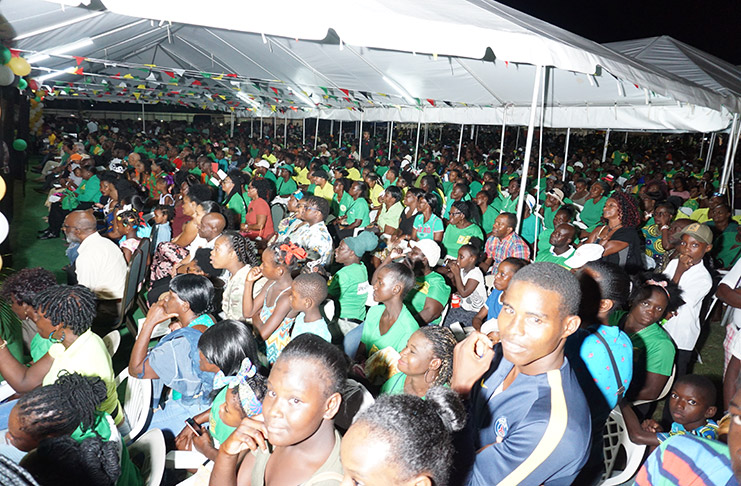
Also in attendance were several ministers of government including Minister of Public Security who is performing duties of Prime Minister, Khemraj Ramjattan; Fourth Vice President, Sydney Allicock; Attorney General and Minister of Legal Affairs, Basil Williams, who is also Chairman of the Village Day Committee; Minister of Social Protection, Amna Ally; Minister of Communities Ronald Bulkan; Minister of Public Telecommunications, Cathy Hughes and Minister of Foreign Affairs Dr Karen Cummings.
Seizing the moment, President Granger congratulated the village for staying the course. “Guyanese will be forever grateful to Victoria – the great grandmother of all villages. We acknowledge that we are all the offspring of the Great Village Movement which Victoria started 180 years ago on 7th November 1839.” President Granger said this anniversary touches everyone in Guyana. “Victoria lit the flambeau that enlightened us to the dream of equality of all people, the prospect of economic prosperity and to the true meaning of liberty from enslavement.” He said the village showed how ordinary folk, with little education, scant savings and meagre means, could transform their conditions of life and-led the way to becoming a model for economic self-sufficiency and democratic empowerment.
To this end he committed that his Government will devote greater resources to financing Village Improvement Plans (VIPS), designed by villages for villagers. “These plans are pistons for powering-up the villages. I offer you a new model, a new motor, for the improvement of all villages,” the Guyanese told the crowd. “Your Government has a plan to help Victoria to lead the Village Movement again – just as it did 180 years ago. It is a four-point Village Improvement Plan (VIP) which can serve as a model for the economic and social revitalisation not only of Victoria but of all of the country’s villages.”
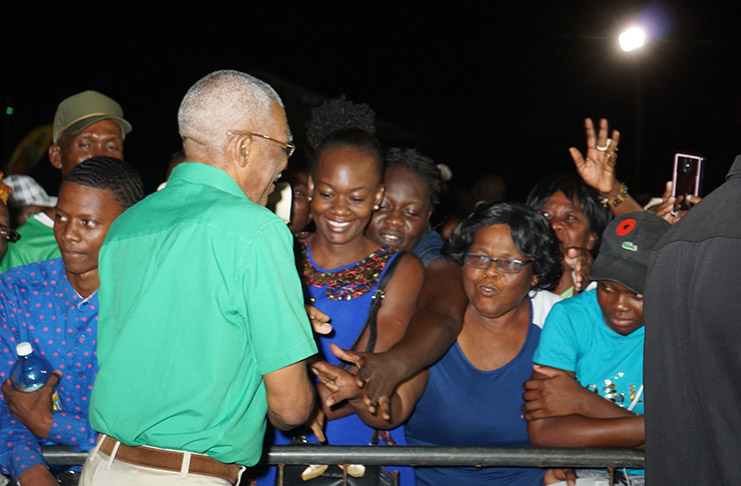
Protect institutions
The first point he said is to protect institutions, noting that villages established in the wake of Emancipation rested on four pillars – the home, the church, the school and the farm. According to the President Village Improvement Plans should aim at strengthening these traditional pillars of our villages. “The home as a place where happy families live; the churches (or other religious houses) which are custodians of the society’s moral values; the farms, markets and workplaces which provide incomes; and the schools which ensure that every child has a place,” the Head-of-State said.
The second point is to improve infrastructure such as drainage and irrigation and farm-to-market roads. According to President Granger VIPs will improve access to modern sanitary services, solid-waste collection and recycling facilities and a healthy environment. The third point he noted is investment which is needed to restore abandoned farmlands; accelerate agro-processing; expand housing for new and future generations; and promote ‘green’ development in small-scale renewable energy systems to power homes and small businesses.
The fourth point is to intensify the use of information technology to provide information services to farmers and fishers about the weather and tides and improve access to markets. “Your Government will launch a Decade of Development 2020-2029 which will sustain local democracy and support village renewal.
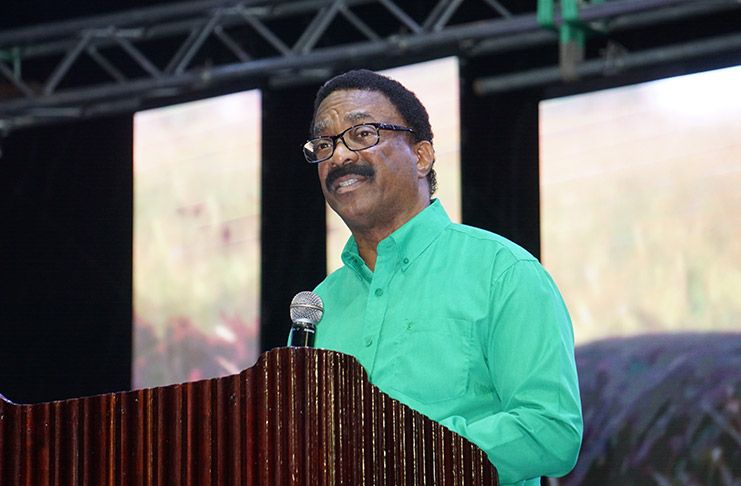
It will ensure improvements in sustaining local democratic organs; in providing better bridges, drainage, irrigation, roads, sanitation services and street lights; and in expanding economic enterprises. The Decade of Development is the future: village economies will thrive through the establishment of micro- and medium-scale enterprises which will provide employment; by growing food, again; producing goods, again; providing services, again; village lands will bloom again by being brought under cultivation; village democracy will flourish again by holding regular local government elections and selecting local leaders who care for their communities and who represent their constituencies; and cultural life will bloom again through the development of socially-cohesive communities in which there are happy homes, happy families and happy neighbours and in which young people can enjoy vibrant athletic activities.”
Permanent place in history
President Granger told the gathering that Victoria has a permanent and proud place in history, noting that the village, which originally comprised about 202 hectares (about 500 acres) and had a depth of 11 km and width of 483m created a demographic and geographic revolution in our country, beginning 180 years ago. “Victoria led the way in establishing a model of village organisation which was imitated across the coast. The purchase of Plantation Northbrook by poor, illiterate folk, ignited a process which transformed an archipelago of plantations into a chain of human settlements stretching from the Corentyne to the Pomeroon Rivers,” the President noted.
He said the Village Movement, has been described as: “the most spectacular and aggressive land settlement movement in the history of the people of the British Caribbean and a movement which seemed [to one planter in British Guiana] to be certainly without parallel in the history of the world!”
The Movement started on 7th November 1839. Eighty-three free men and women from five plantations – Ann’s Grove, Dochfour, Enmore, Hope and Paradise – agreed to pay 30,000 guilders (f 30.000) for Plantation Northbrook. They collected their savings and paid two-thirds of the money right away in coins, delivered in a wheelbarrow, “…some of them still black with the mud in which they had been buried.” The remainder was covered by a promissory note which was redeemed three weeks later.
President Granger reminded villagers that he launched postage stamps, depicting ‘the purchase’ in November 2016 – a landmark of Guyanese history which every child should remember. “Victoria pioneered local government. Its proprietors, seven years after emerging from enslavement ? the worst form of domination and degradation in human history had the wisdom to promulgate a remarkable prototype for local government on 2nd May 1845 – the first Village Improvement Plan.”
The President said the Victoria’s Agreement prescribed twenty detailed ‘regulations’ for the management of the village by its proprietors. These included the election of office-bearers, collection of taxes, the prohibition of drunkenness, cursing, swearing, gambling, etc, trespassing, observing the Sabbath, sale of properties and the use of firearms, among others.
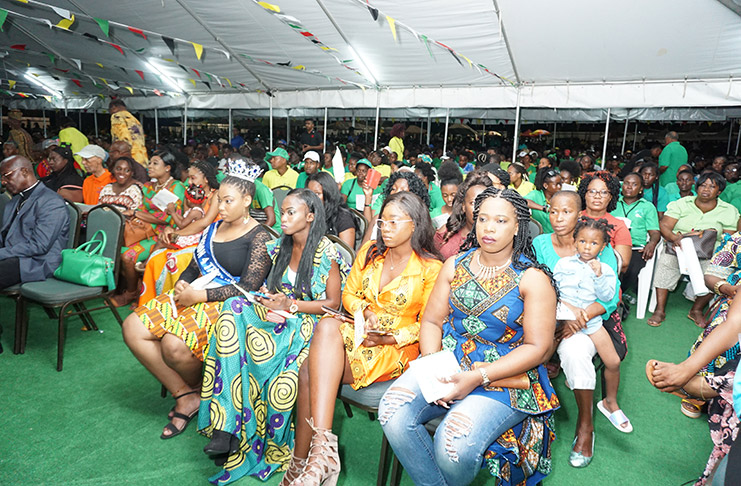
Victoria’s founders, as a result of their advanced thinking, had a head start on other villages and, by the late 19th century: enjoyed a relatively, high cultural standard – influenced by the large number of churches and schools and inspired by a growing group of educated people among whom were parsons and school teachers; established a thriving agro-processing economy based on the production of cassava; coconuts; fruit for beverages, table consumption and preserves and vegetables; encouraged micro-businesses such as bakeries and parlours; cottage industries produced drinking chocolate and households made other beverages for sale; and, employed artisans, blacksmiths, carpenters, tinsmiths and contractors and built and maintained bridges, houses, kokers and other minor public works.
Development over the years
President Granger also spoke about efforts by his government to revive the village. He said village development has restarted, noting that Local Government Elections was the first step in re-empowering citizens to play a greater role in the management of their communities. The second step will be to push village development faster and further. “Your Government, over the past four years, invested G$88.1 M in this village in the fields of agriculture, education, health and public infrastructure. Victoria has benefitted from the reawakening of local democracy. The projects included: repairs to the Middle Walk road; rehabilitation of the heavy duty-bridge at Middle Walk and the footpath linking Victoria and Cove and John; and to culverts, the pump station and to the schools; revetments at West Sideline and East Sideline and excavation of drainage and irrigation canals; and remodelling of the Health Centre and construction of a pharmacy room and dressing area at the Health Centre.
President also took note of the work of the Victoria Reconstruction Trust and Foundation for Real Christian Education which have been supported by the ‘Victorian’ diaspora. “The foundation has been laid, the Village Improvement Plan will help to ensure that the progress achieved, particularly over the past four years, is propelled and sustained.
Meanwhile, AG Williams who is also Chairman of the Victoria Village Day Committee in brief remarks said it was an honour to be part of the celebrations. He hailed the youth group in the village that organised and help run off the event. “Indeed it is a time to reflect where we were as a people and where we have come and going,” Williams told the gathering. He said as ordained in the Bible, the celebration of the village’s anniversary is in place and urged residents to cherish the rich legacy of their ancestors struggle. Williams said too that the occasion represented a landmark of struggle and determination.




.jpg)



